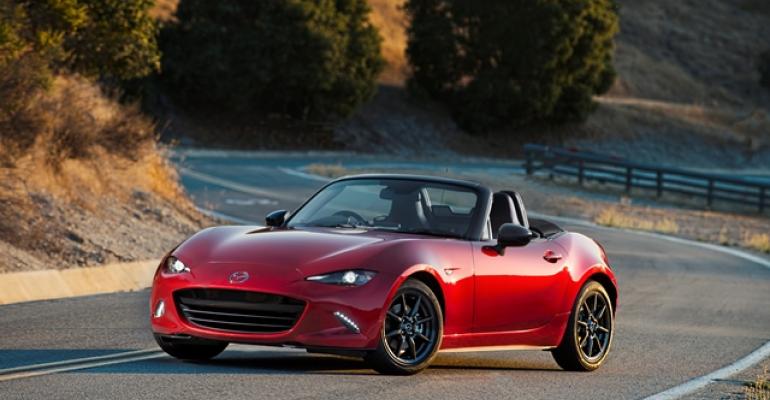Production of the all-new ’16 Mazda MX-5 Miata commenced this week, marking the start of the fourth generation of the sporty roadster beloved by driving enthusiasts worldwide.
Despite its iconic stature, the Miata never has sold in large volume, with peak volume at 75,798 units globally in 1990, the second year it was on sale. Production has exceeded 950,000 units since its launch, earning it a spot in the Guinness Book of World Records as the world’s best-selling 2-seat roadster.
Following its heyday in the 1990s, sales routinely failed to reach the 20,000-unit mark. Europe remains its top market, followed by North America.
In 2014, U.S. sales plunged 17.9% to 4,745 units, according to WardsAuto data. That is low volume even for a halo car. By comparison, the niche-model Subaru BRZ sold 7,504 last year, while the Chevrolet Corvette posted 9,461 deliveries.
Although there are lower-volume vehicles than the Miata, most come from larger automakers better able to absorb the cost of development.
Even though it’s a relatively small automaker, Mazda continues to invest in improving the Miata, even though the rear-wheel-drive roadster shares little with other vehicles in the automaker’s lineup.
Jim O’Sullivan, president and CEO-Mazda North America, says that’s because the MX-5 Miata is more to the brand than just another vehicle.
“It’s our anchor, our heart,” he tells WardsAuto. “Everything we build and everything we do in R&D has to have a little MX-5 in it or we won’t go into that segment.”
O’Sullivan declines to reveal Mazda’s investment in the all-new ’16 Miata but says manufacturing costs are kept to a minimum due to lean-manufacturing techniques used in the Hiroshima and Fuchu, Japan, plants.
“We build Miata on the same line as CX-5, CX-9 and Mazda5,” he says. “It makes sense for a company like us.”
The Miata also is sold in many markets, including Europe, Canada, Mexico, Central America, Australia, Japan and China.
“The volume is not big, but it’s a very productive and successful car within the company portfolio,” O’Sullivan says.
Mazda is defraying some of the development costs via a partnership with FCA. Originally, plans called for FCA’s Alfa Romeo brand to develop a new Spider roadster based on the Miata, but it’s the Fiat brand that now will use the new Miata platform to revive the iconic 124 roadster.
“We still have an agreement in place (with FCA),” says Mazda spokesman Eric Booth. “Mazda is leading the development of vehicles for both brands. However, vehicles of each brand are differentiated and they have distinctive brand characteristics. Fiat leads its design development and engine development for its brand vehicle.”
The’16 MX-5 Miata weighs in 220 lbs. (100 kg) lighter than its predecessor due to an aluminum hood, trunk lid, front fender and front and rear bumper reinforcements. The weight of the roadster’s soft top also has been reduced.
The pedals, controls and other equipment have been repositioned for comfort and to keep the driver’s eyes on the road. For better visibility, an issue with earlier-generation Miatas, the hood has been lowered and the A-pillars and windshield header have been moved rearward and made thinner.
For improved driving dynamics, the car gets a new double-wishbone front and multilink rear suspension and the engine is relocated closer to the vehicle’s center, allowing for 50:50 front-rear weight distribution.
A 6-speed manual or automatic transmission is mated to a 2.0L Skyactiv direct-injection gasoline engine producing 155 hp and 148 lb.-ft. (200 Nm) of torque.
Outside, the new Miata incorporates Mazda’s Kodo design language, which the automaker describes as the “muscular beauty you see when an animal pounces.”
Perhaps most importantly, at just 12.8 ft. (3.9 m) long and 4.0 ft. (1.2 m) tall, the Miata retains its tiny proportions in an industry where most models have grown larger over the years.
“The math works,” O’Sullivan says of the new Miata. “We wouldn’t be developing and doing the next generation if it wasn’t successful.”





